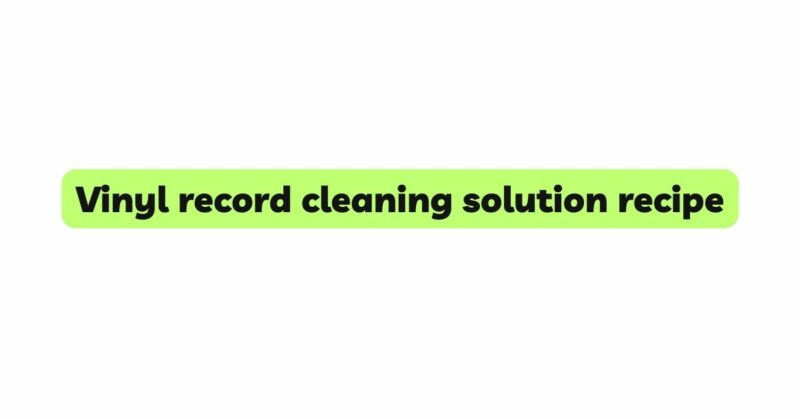Vinyl records, cherished for their warm analog sound and nostalgic charm, require proper care and maintenance to ensure optimal audio fidelity and longevity. Regularly cleaning your vinyl records is essential to remove dust, dirt, and contaminants that can compromise sound quality and diminish the overall listening experience. While there are many commercial vinyl record cleaning solutions available on the market, some audiophiles prefer to create their cleaning solution to suit their preferences and budget. In this article, we will provide a step-by-step guide to creating your DIY vinyl record cleaning solution, using easily accessible and safe ingredients.
Why Clean Your Vinyl Records?
Vinyl records, despite their appeal, are susceptible to various types of damage over time. Dust, dirt, and oils from fingerprints can accumulate on the playing surface, leading to unwanted pops, clicks, and surface noise during playback. Additionally, contaminants on the grooves can cause unnecessary wear on the stylus, which can affect the sound quality and ultimately damage the record itself.
Properly cleaning your vinyl records not only enhances their audio fidelity but also ensures their longevity. A clean record allows the stylus to track smoothly, reducing friction and preserving the grooves. Regular maintenance can help you enjoy your vinyl collection for years to come.
DIY Vinyl Record Cleaning Solution Recipe
Before we begin, it is essential to emphasize that cleaning vinyl records requires gentle and careful handling. Avoid using abrasive materials or harsh chemicals that could damage the record surface. The following recipe utilizes safe and effective ingredients that are readily available and won’t harm your vinyl records:
Ingredients:
- Distilled Water: Distilled water is free of impurities, minerals, and contaminants commonly found in tap water. Using distilled water helps prevent residue buildup on your records during the cleaning process.
- Isopropyl Alcohol: Isopropyl alcohol is a commonly used cleaning agent that evaporates quickly, leaving no residue behind. It helps to dissolve oils, greases, and stubborn contaminants on the record surface.
- Surfactant: A surfactant is a compound that reduces the surface tension of the cleaning solution, enabling it to spread and penetrate the grooves more effectively. A drop of mild dishwashing detergent can serve as a surfactant.
- Spray Bottle: Use a clean and empty spray bottle to mix and apply the cleaning solution to the record.
- Soft Microfiber Cloth or Record Brush: A soft microfiber cloth or a dedicated record brush will be used to gently clean the record surface.
Step-by-Step Cleaning Guide:
Step 1: Prepare the Cleaning Solution
In a clean bowl or container, combine the following ingredients:
- 300 ml of distilled water
- 100 ml of isopropyl alcohol (99% concentration, if possible)
- A drop of mild dishwashing detergent (optional)
Stir the mixture gently to ensure even distribution of the components. The dishwashing detergent is optional, but it can enhance the cleaning effectiveness of the solution.
Step 2: Fill the Spray Bottle
Using a funnel, carefully pour the cleaning solution into an empty and clean spray bottle. Label the bottle to indicate that it contains a vinyl record cleaning solution.
Step 3: Preparing the Vinyl Record
Before applying the cleaning solution, inspect the record for visible dust and debris. Gently remove any surface dust with an anti-static brush or a carbon fiber brush.
Step 4: Applying the Cleaning Solution
Lay the vinyl record on a clean, soft, and lint-free surface. Hold the spray bottle about 10-12 inches away from the record and lightly mist the solution onto the playing surface. Avoid spraying the label or the center of the record.
Step 5: Cleaning the Record
Using a soft microfiber cloth or a record brush, gently wipe the record in a circular motion, following the grooves. Start from the center of the record and work your way outwards. Be patient and avoid applying excessive pressure, as this could damage the grooves.
Step 6: Drying the Record
Allow the record to air dry completely before returning it to its sleeve. Avoid using heat or a hairdryer to speed up the drying process, as this can cause warping or other damage to the vinyl.
Step 7: Storing the Record
Once the record is completely dry, return it to its protective inner sleeve and outer sleeve. Store the record upright in a cool, dry place, away from direct sunlight and sources of heat.
Conclusion
Regularly cleaning your vinyl records using a DIY vinyl record cleaning solution is a simple yet effective way to preserve their sound quality and longevity. By using safe and readily available ingredients like distilled water, isopropyl alcohol, and a drop of mild dishwashing detergent, you can create an effective cleaning solution that won’t harm your cherished vinyl collection. Remember always to handle your records with care and use gentle cleaning techniques to maintain their pristine condition. By incorporating this DIY cleaning regimen into your vinyl record maintenance routine, you can ensure that each listening session is a true delight, with the rich, warm sound that vinyl enthusiasts know and love. Happy listening!

